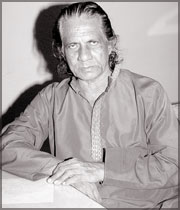Fifty years of dancing
by Aditha Dissanayake
Kathakali which originated in Kerala, South India, over 500 years ago
is a spectacular dance form which combines dance, music and ritual to
re-enact stories from the Hindu epics, the Mahabharatha and the
Ramayana.
As Dr. Basil Mihiripenna, the doyen of Kathakali dance, would have
told you one of the most interesting aspects of Kathakali is its
elaborate make-up code. Characters are categorised according to their
nature represented by the colours used in their make-up.
|

Dr. Basil Mihiripenna |
The faces of noble male characters, such as virtuous kings, the
divine hero Rama, etc. are predominantly green. Characters of high birth
who have an evil streak, such as the demon king Ravana, are allotted a
similar green make-up but slashed with red marks on the cheeks.
Extremely angry or excessively evil characters wear red make-up and a
flowing red beard. Forest dwellers such as hunters are represented with
a predominantly black make-up base. Women and ascetics have lustrous,
yellowish faces.
The technique of Kathakali includes a highly developed language of
gesture, through which the artist can convey whole sentences and
stories. The body movements and footwork are very rigorous. To attain
the high degree of flexibility and muscle control required for this art,
a Kathakali dancer undergoes a strenuous course of training, and special
periods of body massage...
Commenting on the high quality of the Kathakali dance tradition he
had observed in India, Dr. Mihiripenna says "The secret of this high
standard can be attributed to several facts. One is the support given by
the government which enables the art institutes to offer scholarships to
students, providing them with residential facilities, and the
opportunity of studying the intricate movements of the art with total
devotion for at least six years".
Another reason says Dr. Mihiripenna is the faith they have in the
guru-kula system. "Their aim is to create professionals in art". In
order to do so, students wake-up as early as four in the morning and
spend more than eight hours practising the dance movements.
"This training is essential because the Kathakali dance tradition is
a performing art which needs more concentration on the practical side
than on theory".
In order to give Sri Lankan students too a chance to get a
professional training in dancing, drumming and folk-songs Dr.
Mihiripenna had established a school of his own called Deepasika Kala
Sarasaviya way back in 1958.
The school will be celebrating its 50th anniversary on 26 January at
Piliyandala and at the John de Silva Theater on February 29,2008. "We
will be giving fifty scholarships to underprivileged students" says Dr.
Mihiripenna. Well wishers who wish to send contributions could contact
Dr. Mihiripenna on 2615258.
[email protected]
|
